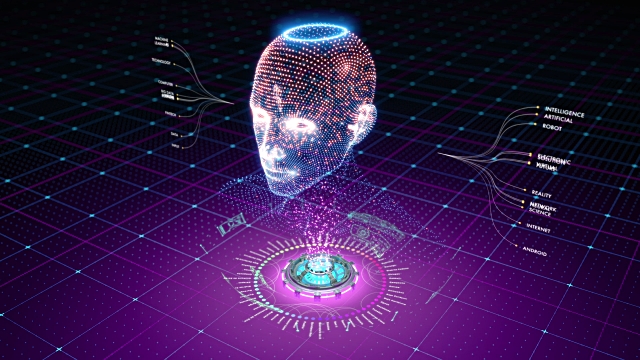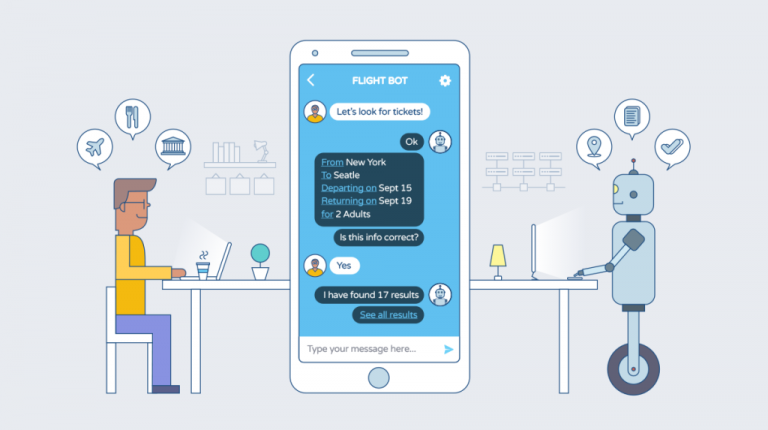
Artificial Intelligence – Another era of technology !
What is AI ?
The science and engineering of making intelligent machines, especially intelligent computer programs – John McCarthy, Father of Artificial Intelligence(AI)
Artificial intelligence (AI) ( also called as Machine Intelligence) is intelligence demonstrated by machines. It is basically the way of simulating human intelligence processed by machines. These processes include learning, reasoning, self-correction etc.
In Computer Science,vAI research is defined as the study of ‘intelligent agents‘.
An intelligent agent is any device that perceives its environment and takes actions that maximize the chances of successfully achieving its goals.
Knowledge engineering is an important part of AI research. A machine can act or react like humans only if it has a huge knowledge base based on which it can reason, plan, make decisions, solve problems and do wonders.
Goals of AI
- To Create Expert Systems − The systems which exhibit intelligent behavior, learn, demonstrate, explain, and advice its users.
- To Implement Human Intelligence in Machines − Creating systems that understand, think, learn, and behave like humans.
What Contributes to AI:
AI is based on multiple disciplines such as Computer Science, Maths, Neuron Science, Biology, Sociology etc.
Artificial Neural Network:
An artificial neural network is an interconnected group of nodes similar to the vast network of neurons in an animal brain. The connections between artificial neurons are called ‘edges’. Each connection is capable of transmitting a signal from one neuron to another. An artificial neuron that receives a signal can process it and then signal additional neurons connected to it.
Artificial Neural Network is, usually, a supervised method of learning. It processes on a data set or training set. Such networks can make connections and reach meanings without relying on pre-defined behavioral algorithms. For example, if a training set contains images of dogs then systems with ANN can identify dogs in other images, without any prior knowledge of the characteristics of a dog. They learn from the training set they process.
ANN are aggregated into three layers- Input Layer, Hidden (computation) Layers and Output Layer. Different layers may perform different kinds of transformations on their inputs. Signals travel from the first layer (the input layer) to the last layer (the output layer), possibly after traversing the layers multiple times.
Furthermore, learning happens in two steps: Forward-Propagation and Back-Propagation. Forward-Propagation includes predicting an answer or result whereas Back-Propagation is minimizing the error between actual answer/result and predicted answer/result.
Deep Learning
Deep learning is an approach of using ANN with lots of nodes. It is being used in many applications that we are using in daily life such as image recognition, sound recognition, recommended systems, etc.
Deep learning algorithms are stacked in a hierarchy of increasing abstraction. It gains its knowledge by building a hierarchy in which each level of abstraction is created with the knowledge that was gained from the preceding layer of the hierarchy.
A famous example of deep learning is – deep learning is part of DeepMind’s well-known AlphaGo algorithm, which beat the former world champion Lee Sedol at Go in early 2016, and the current world champion Ke Jie in early 2017.

Picture Credits : Atomik Research
Benefits of AI:
- Enhances Efficiency
It is well known that machines can more efficiently perform tasks with more precision. AI replicates the decisions and actions of humans without human shortcomings, such as fatigue, emotion and limited time and therefore increases efficiency.At the University of California, San Francisco, a robotic pharmacist is dispensing prescriptions better than most humans. In over 3,50,000 doses, not even one error was found. The robot was also able to better judge whether medications would interact with each other in specific patients. - Immunity to Hazards
Machines can be repaired, but people cannot when serious injuries occur. That’s why it’s important that robots take over tasks that can be hazardous to humans like manufacturing automobiles, welding, sanding and polishing. That is why robots are being used in dangerous tasks like bomb defusal.Intelligent robots are fed with information and are sent to explore space. Since they are machines with metal bodies, they are more resistant and have greater ability to endure the space and hostile atmosphere than humans.They are designed and acclimatized in such a way that they cannot get disfigured or breakdown in a hostile environment. - Repetitive Jobs
Repetitive jobs which are monotonous in nature can be carried out with the help of machine intelligence thus freeing humans to do more productive work. Machines think faster than humans and can be put to multi-tasking. Machine intelligence can be employed to carry out dangerous tasks. Their parameters, unlike humans, are calculation based and can be adjusted eg their speed, direction, time etc. - No Breaks
Machines, unlike humans, do not require frequent breaks and refreshments. They are programmed to work for long hours and can continuously perform without getting bored or distracted or even tired. - Difficult Exploration
Robots with AI can be used in mining and other fuel exploration processes. Not only that, these complex machines can be used for exploring the ocean floor and hence overcome the human limitations.Robots can perform more laborious and hard work with greater responsibility. Moreover, they do not wear out easily and thus are very useful in exploration.
APPLICATIONS OF AI
- Gaming
Based on heuristic knowledge machines with AI can think of a large number of possible actions or positions than most humans. Hence they are very efficient in playing strategic games such as chess, poker, tic-tac-toe, etc. - Natural Language Processing
Nowadays it is possible to interact with the machines that understand the natural language spoken by humans. Siri, Google Assistant, Alexa, and Cortana are a good example of such machines. - Expert Systems
An expert system is a computer program that uses AI techniques to simulate expert judgments and behavior. Two early expert systems in the healthcare space are Dendral, which helped chemists identify organic molecules, and MYCIN, which helped to identify bacteria such as bacteremia and meningitis and to recommend antibiotics and dosages.A more recently developed expert system, ROSS, is an artificially-intelligent attorney based on IBM’s Watson cognitive computing system. ROSS relies on self-learning systems that use data mining, pattern recognition, deep learning, and natural language processing to simulate the way the human brain works. - Vision Systems
These systems understand, interpret, and comprehend visual input on the computer. It is used in various applications such as-- Electronic component analysis
- Signature identification
- Optical character recognition
- Handwriting recognition
- Object recognition
- Pattern recognition
- Materials inspection
- Currency inspection
- Medical image analysis
- Speech Recognition:
Some intelligent systems are capable of hearing and understanding the words and phrases and their meanings while a human talks to it. It can handle different accents, slang words, noise in the background, change in human’s noise due to cold, etc.Speech recognition works using algorithms through acoustic and language modeling. Acoustic modeling is used to represent the relationship between speech units and audio signals, language modeling is used to differentiate between Homophones and Markov models are used to recognize temporal patterns in speech. Applications of speech recognition are call routing, speech-to-text processing, voice dialing, and voice search.
- Self Driving Cars
A self-driving car also known as an autonomous car is a car which can move with little or no human input. AI in transportation is expected to provide benefits like reduced costs, increased safety, increased mobility, increased customer satisfaction, and reduced crime. Self-driving cars will also mean lesser road accidents as they are programmed to focus more on safety than human drivers. - Medical Applications
Doctors assess the patients and their health risks with the help of machines having artificial intelligence. A popular application of artificial intelligence is radiosurgery, used in operating tumors. This can actually help in the operation without damaging the surrounding tissues.
Timeline of AI Growth !

Some Major Works in AI
These are some of the most popular examples of artificial intelligence that’s being used today.
Nest:
Nest Learning Thermostat is a smart thermostat developed by Nest labs and acquired by Google in January of 2014 for $3.2 billion. This thermostat can now be voice controlled by Alexa. It is a wifi enabled device which learns user’s temperature needs and optimizes heating and cooling of homes and businesses to conserve energy. It has built-in sensors and can track phone locations and can shift into energy saving mode when nobody is at home.
Cogito:
Cogito analyzes voice signals in phone conversations and empowers agents to build better rapport on every call. Cogito’s AI has replaced the traditional approach to customer experience measurement. The software performs streaming analysis of voice conversations and provides representatives with in-call guidance that helps them be more confident and empathetic. Cogito automatically provides insight into a customer’s perception of an interaction and uses deep learning to improve over time.
Alexa
Alexa is a virtual assistant developed by Amazon. It is capable of voice interaction, music playback, making to-do lists, setting alarms, streaming podcasts, playing audiobooks, and providing weather, traffic, sports, and other real-time information, such as news.[3] Alexa can also control several smart devices using itself as a home automation system.
Siri
Siri is also a virtual assistant that is part of Apple Inc.’s iOS, watchOS, macOS, HomePod, and tvOS operating systems. Siri uses advanced machine learning technologies to function. Siri’s speech recognition engine was provided by Nuance Communications, a speech technology company. Siri responds to users’ spoken questions by speaking back to them through the device’s speaker and presenting relevant information on the home screen from certain apps, such as Web Search or Calendar. The service also lets users dictate emails and text messages, reads received emails and messages and performs a variety of other tasks.
Concerns and Criticisms
A huge focus right now for startups and giants alike is to learn how to use AI to help better automate a machine’s ability to solve problems on the fly. From SIRI to self-driving cars, artificial intelligence (AI) is progressing rapidly.
AI no doubt has remarkable benefits to offer but there are notable unanswered questions with social, political or ethical facets. The main concern is the large-scale unemployment that can be caused by AI. People with nothing to do can lead to the destructive use of their creative minds. Artificial intelligence in wrong hands is a serious threat to mankind in general. It may lead to mass destruction. Also, there is a constant fear of machines taking over or superseding the humans.
Nick Bostrom( director of Oxford’s Future of Humanity Institute), In his 2014 book Superintelligence: Paths, Dangers, Strategies, Bostrom warns that AI could quickly turn dark and dispose of humans. The subsequent world would harbor economic miracles and technological awesomeness, with nobody there to benefit, like Disneyland without children.
Stephen Hawking(theoretical physicist, author, and pioneer of black hole physics) said that it could be the biggest event in human history, helping wipe out war, disease, and poverty. But with its potential to grow so explosively it could wind up outsmarting financial markets, out-inventing human researchers, out-manipulating human leaders, and developing weapons we cannot even understand. It could be the last event in our history unless we learn how to avoid the risks.
We believe research today will help us better prepare for and prevent such potentially negative consequences in the future, thus enjoying the benefits of AI while avoiding pitfalls.


